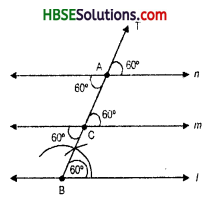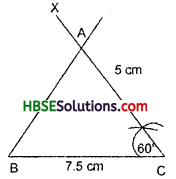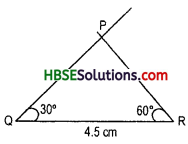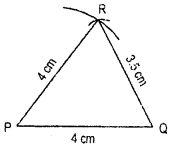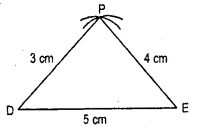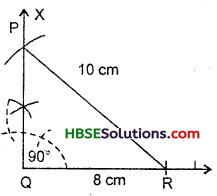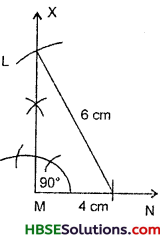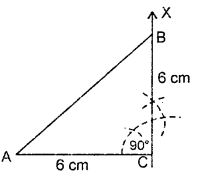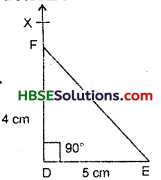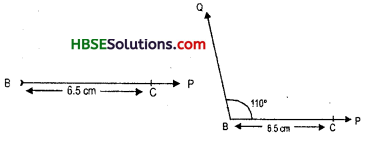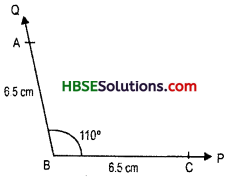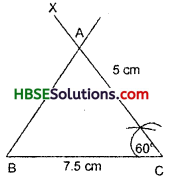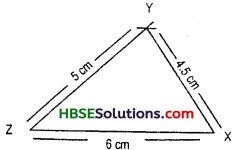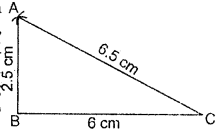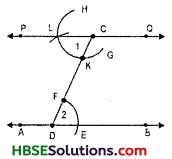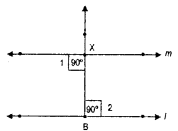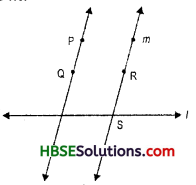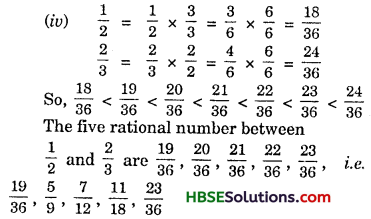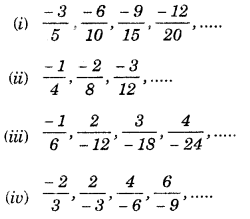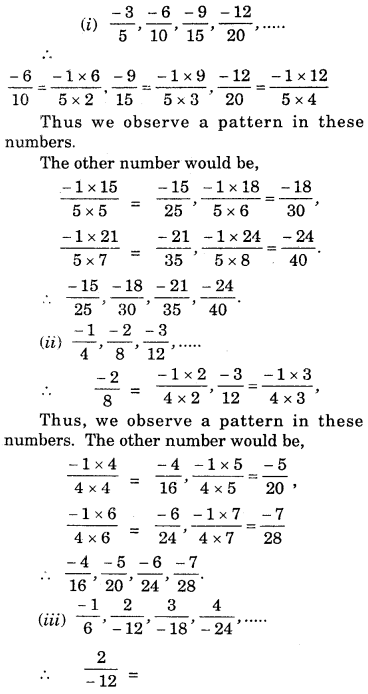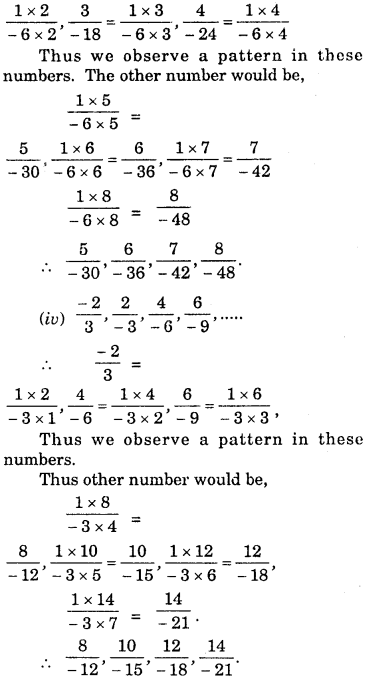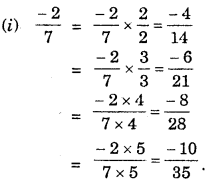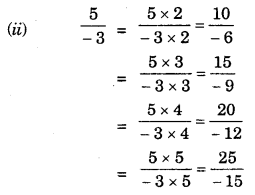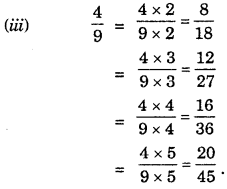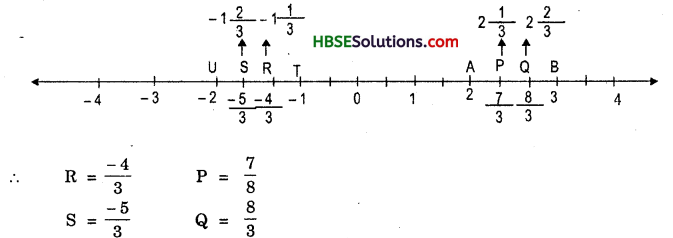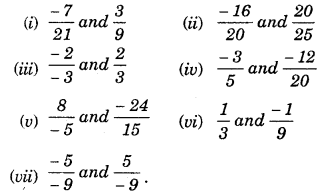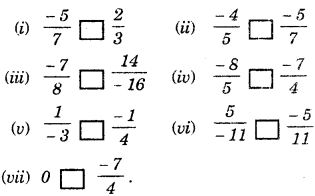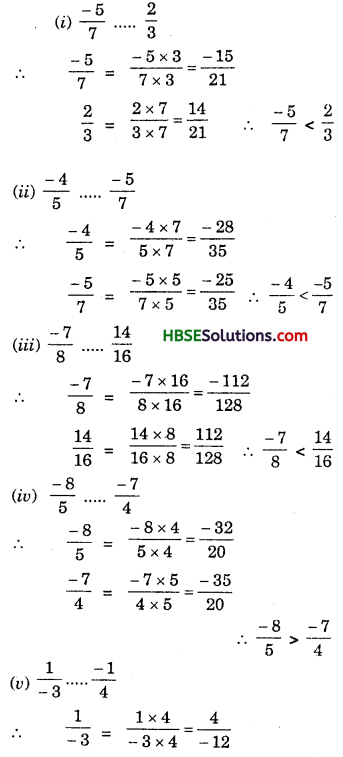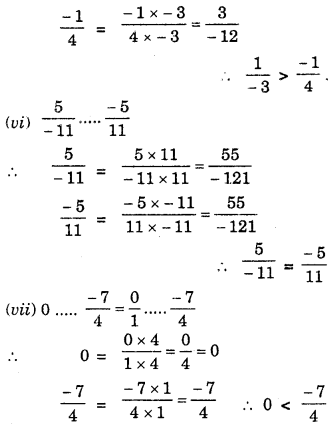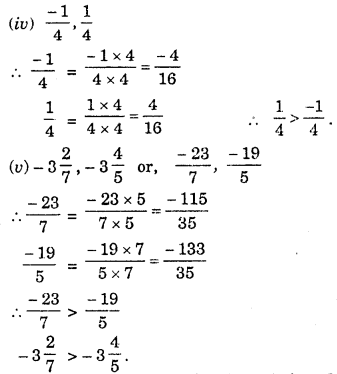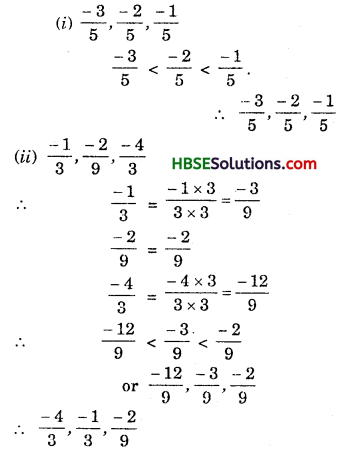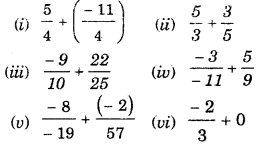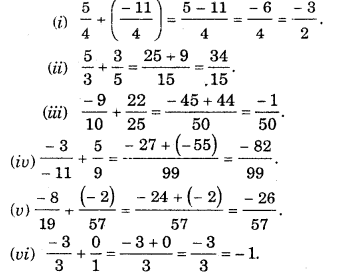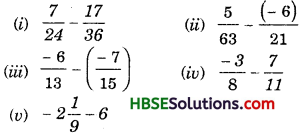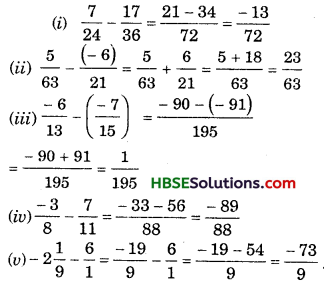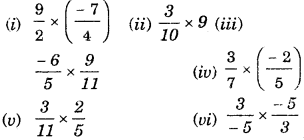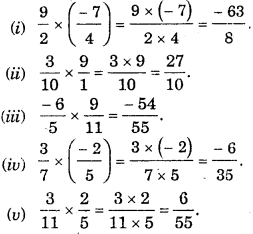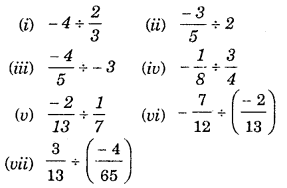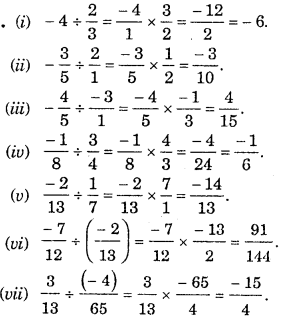Haryana State Board HBSE 7th Class Maths Solutions Chapter 8 Comparing Quantities InText Questions and Answers.
Haryana Board 7th Class Maths Solutions Chapter 8 Comparing Quantities InText Questions
Question 1.
An ant can carry 50 times its weight. If a person can do the same, how much would you carry ?
Solution:
If an ant carry 50 times its weight. Then, a person carry 50 times its weight.
If a person of weight = 50 kg.
Then, a person carry 50 x 50 = 2500 kg.
Question 2.
Find the percentage of children of different heights for the following data:
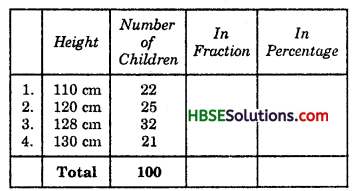
Solution:
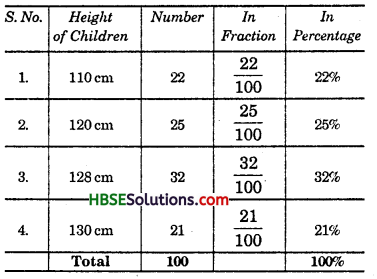

Question 3.
A shop has the following number of shoe pairs of different sizes:
Size 2 20
Size 3 30
Size 4 28
Size 5 14
Size 6 8
Write this informal in tabular form as done earlier and find the percentage of each shoe size available.
Solution:
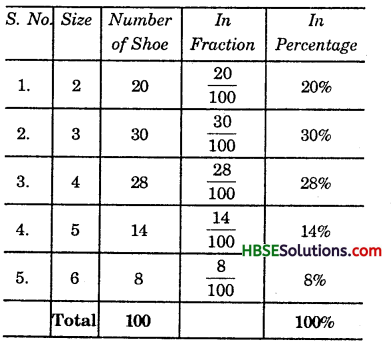
Question 4.
A collection of 10 chips is with different colours is given.
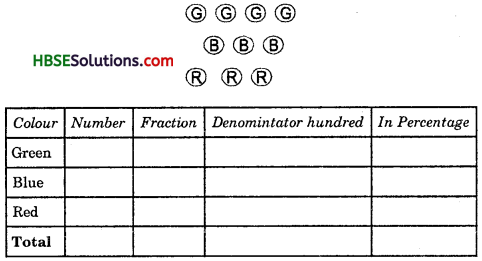
Fill the table and find the percentage of chips of chips of each colour?
Solution:
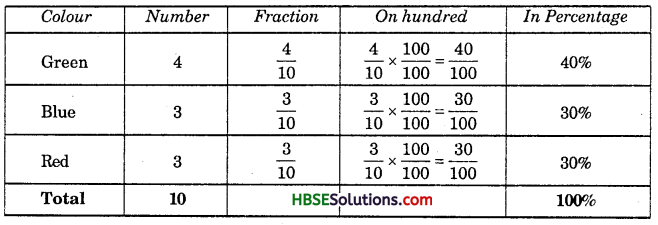

Question 5.
Mala has a collection of bangles. She has 20 gold bangles and 10 silver bangles. What is the percentage of bangles of each type ? Can you put it in the tabular form as done in the above example ?
We have seen that percentages also can be used for comparing quantities.
Solution:

Question 6.
Look at the examples below and in each of them, discuss which is better for comparison.
Solution:
In the atmosphere, 1 g of air contains :
.78 g Nitrogen
.21 g Oxygen
.01 g Other gas
Solution:
1 g of air = 0.78g + 0.21g + 0.01g = 1.00g
or, 100% of air = 78% + 21% + 1% = 100%
or,0.78 g Nitrogen = \(\frac{0.78}{100}=\frac{78}{100}\) =78%
0.21 g Oxygen = \(\frac{0.21}{100}=\frac{21}{100}\) = 21%
0.01 g Other gas = \(\frac{0.01}{100}=\frac{1}{100}\) = 1%
Question 7.
A shirt has :
3/5 Cotton or 60% Cotton
2/5 Polyster 40% Polyster
Solution:

Question 8.
(i) Can you eat 50% of a cake ?
Can you eat 100% of a cake ?
Can you eat 150% of a cake ?
(ii) Can a price of an item go up by 50% Can a price of an item go up by 100% Can a price of an item go up by 150%
Solution:
(i) Yes, Yes, No.
(ii) Yes, Yes, Yes.
Question 9.
Convert the following to percents :
(a) \(\frac{12}{16}\)
(b) 3.5
(c) \(\frac{49}{50}\)
(d) \(\frac{2}{2}\)
(e) 0.05
Solution:
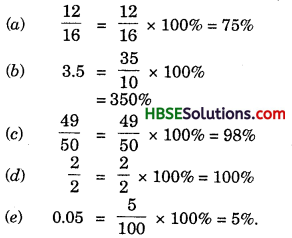

Question 10.
(i) Out of 32 students, 8 are absent. What per cent of the students are absent ?
(ii) There are 25 radios, 16 of them are out of order. What percent radio are out of order?
(iii) A shop has 500 parts, out of which 5 are defective. What percent are defective ?
(iv) There are 120 voters, 90 of them voted yes. What percent voted yes ?
Solution:
(i) Percentage of absent = \(\frac{8}{32}\) x 100% = 25%
(ii) Percentage of out of order \(\frac{16}{25}\) x 100% = 64%
(iii) Percentage of defective = \(\frac{5}{500}\) x 100% = 1%
(iv) Percentage of yes = \(\frac{90}{120}\) x 100% = 75%.
Question 11.
Converting percentages to fractions or decimals :
We have so far converted fractions and decimals to percentages. We can also do the inverse that is when given percentages we can convert it to decimals or fractions. Look at the table, observe and complete it:
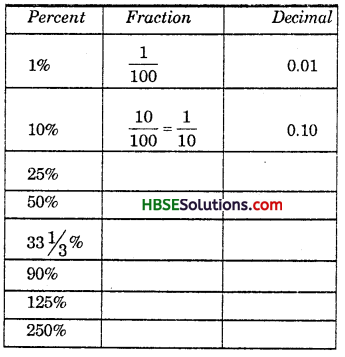
Make some more such examples and solve them.
Solution:
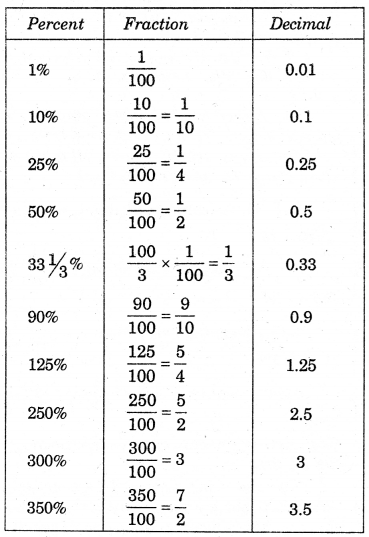
Question 12.
35% + ………….% = 100%
64% + 20% + ………….% = 100%
45% = 100%- ………….%
70% =…………. % – 30%
Solution:
(100-35)% = 65%
[100-(64+ 20)]% = (100-84)%
= 16%
(100-45)% = 55%
(70 + 30)% = 100%

Question 13.
If 65% of students in a class have a bicycle, what percent of the student do not have bicycles
Solution:
Percentage of not have cycles
= (100-65)%
= 35%
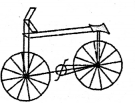
Question 14.
We have a basket full of apples, oranges and mangoes. If 50% are apples, 30% are oranges, then what percent are mangoes ?

Solution:
Percentage of mangoes
= [100-(50+ 30)]%
= (100-80)% = 20%
Question 15.
Consider the expenditure made on a dress 20% on embroidery, 50% on cloth, 30% on stitching. Can you thind of more such examples ?
Solution:
Yes; consider the expenditure made on a building.
20% on labours, 50% on bricks, 30% on cement and etc.
Question 16.
What per cent of these figures are sheded. You can now make some figures yourself and ask your friends to estimate the shaded parts.
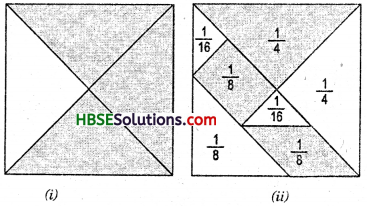
(i) Percentage of shaded parts 75
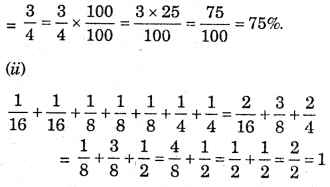
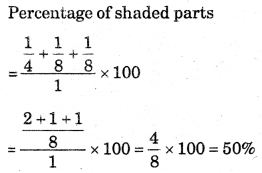

Question 17.
Find (a) 50% of 164
(b) 75% of 12
(c) 12 1/2 % of 64
Solution:
(a) 50% of 164 = \(\frac{50}{100}\) x 164 = 82
(b) 75% of 12 = \(\frac{75}{100}\) x 12 = 9
(c) 12 1/2 % of 64 = \(\frac{25}{2} \times \frac{1}{100}\) x 64 = 8
Question 18.
8% children of a class of 25 like getting wet in rains. How many children like getting wet in rains ?
Solution:
8% of 25 = \(\frac{8}{100}\) x 25 = 2
Hence, 2 children like getting wet in rains.
Question 19.
9 is 25% of what number ?
Solution:
25% of x = 9
\(\frac{25}{100}\) x x = 9
\(\frac{x}{4}=\frac{9}{1}\)
Hence no. x = 4 x 9 = 36.
Question 20.
75% of what number is 15 ?
Solution:
Let be no. be x.
75% of x = 15
\(\frac{75}{100}\) x x = 15
\(\frac{3x}{4}\) = 15 3x = 15 x 4
x = \(\frac{15 \times 4}{3}\) = 20
Question 21.
Divide 15 sweets between Manu and Sonu so that they get 20% and 80% of them respectively.
Solution:
Manu gets,
20% of 15 sweets = \(\frac{75}{100}\) x 15 = 3 sweets Sonu gets,
80% of 15 sweets = \(\frac{75}{100}\) x 15 = 12 sweets
Question 22.
If angles of a triangle are in ratio 2:3:4. Find one value of each angle.
Solution:
The sum of angles of a triangle
Let x be an angle = 180°
Hence, 2x + 3x + 4x = 180°
or, 9x = 180°
or x = \(\frac{180°}{9}\)
or, x = 20 = one value of each angle.
i.e., 40°, 60°, 80° are the three angles of a triangle.

Question 23.
Find percentage of increase or decrease.
(i) Price of shirt decreased from Rs. 80 to Rs. 60.
(ii) Marks in a test in creased from 20 to 30.
Solution:
Percent increase or decrease
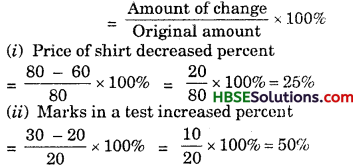
Question 24.
My mother says, in her childhood petrol was Rs. 1 a litre. It is Rs. 52 per litre today. By what percentage gas the price gone up ?
Solution:
Original rate of one litre petrol = Rs.1
The increase in rate of one litre petrol
= Rs. 52 – Rs. 1 = Rs. 51
∴ Percentage increase
Amount of change = \(\frac{Amount of change}
{Original amount}\) x 100%
= \(\frac{51}{1}\) x 100 = 5100%
Hence, 5100% has price gone up.
Question 25.
A shopkeeper bought a chair for Rs. 375 and sold it for Rs. 400. Find the gain percentage.
Solution:
C.P. = Rs. 375, S.P. = Rs. 400
Gain = S.P. – C.P. = 400 – 375
= Rs. 25.
∴ Gain % = \(\frac{\text { Gain }}{\text { C.P. }}\) x 100%
\(\frac{25}{375} \times 100=\frac{20}{3}=6 \frac{2}{3} \%\)
Question 26.
Cost of an item is Rs. 50; It was sold with a profit of 12%. Find the selling price.
Solution:
C.P. = Rs. 50, S.P. = ?
Gain % = 12%

Question 27.
An article was sold for Rs. 250 with a profit of 5%, then what is the cost price ?
Solution:
C.P = ?
S.P. = Rs. 250, Gain% = 5%

Question 28.
An item sold for Rs. 540 at a loss of 5%. What was its cost price ?
Solution:
S.P. = Rs. 540, C.P. = ?
loss% = 5%


Question 29.
Rs. 10,000 is invested at 5% interest rate p.a. Find the interest at end of one year.
Solution:
Here, P = Rs. 10,000, R = 15%,
T = 1 year
∵ S.I = \(\frac{\mathrm{PRT}}{100}\)
∴ S.I = \(\frac{10,000 \times 15 \times 1}{100}\) = Rs. 1,500
Question 30.
Rs. 3500 is given at 7% p.a. rate of interest. Find the interest which will be received at end of two years.
Solution:
P = Rs. 3500, R = 7%, T = 1 year
∴ S.I = \(\frac{3,500 \times 7 \times 1}{100}\) = Rs. 245
Question 31.
Rs. 6050 is borrowed at 6.5% rate of interest p.a. Find the interest and the amount to be paid at the end of 3 years.
Solution:
P. = Rs. 6050,
R = 6.5%, T = 3 years
S.I = \(\frac{6,050 \times 6.5 \times 3}{100}\) = Rs. 395.25 100
P + I = 6050 + 395.25
.’. Amount = Rs. 6445.25
Question 32.
Rs. 7000 is borrowed at 3.5% rate of interest p.a. borrowed for 2 years. Find the amount to be paid at end of second year. Solution:
P = Rs. 7,000, R = 3.5%,
T = 2 years.
S.I = \(\frac{7,000 \times 3.5 \times 2}{100}\) = Rs 280
A = P + I
Amount = 7000 + 280 = Rs. 7280.
Question 33.
If you had Rs. 2400 in your account and the interest rate were 5%. After how many years would you earn Rs. 240 as interest ?
Solution:
P = Rs. 2400, R = 5%, T = ?
S.I. = Rs. 240
S.I = \(\frac{\text { PRT }}{100}\)
T = \(\frac{\text { S.I. } \times 100}{\mathrm{PR}}\)
T = \(\frac{2400 \times 100}{2400 \times 5}\) = 2 years

Question 34.
If on a certain sum the interest paid after 3 years is Rs. 450 at 5% rate of interest per annum. Find the sum.
Solution:
Here, P = ? R = 5%, T = 3 years
= Rs. 450
∵ S.I = \(\frac{\text { PRT }}{100}\)
∴ P = \(\frac{\text { S.I. } \times 100}{\mathrm{RT}}\)
∴ P = \(\frac{450 \times 100}{5 \times 3}\)
∴ The sum = Rs. 3000.
![]()
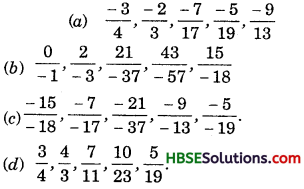


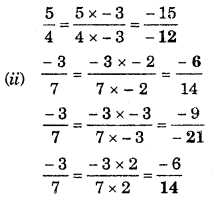
![]()
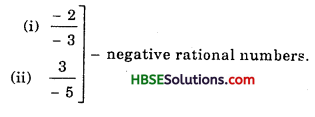
![]()
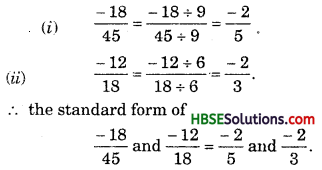


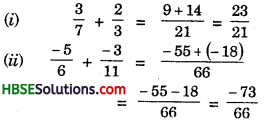
![]()
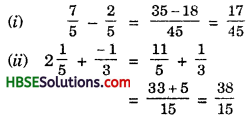

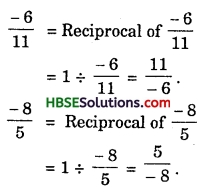
![]()
